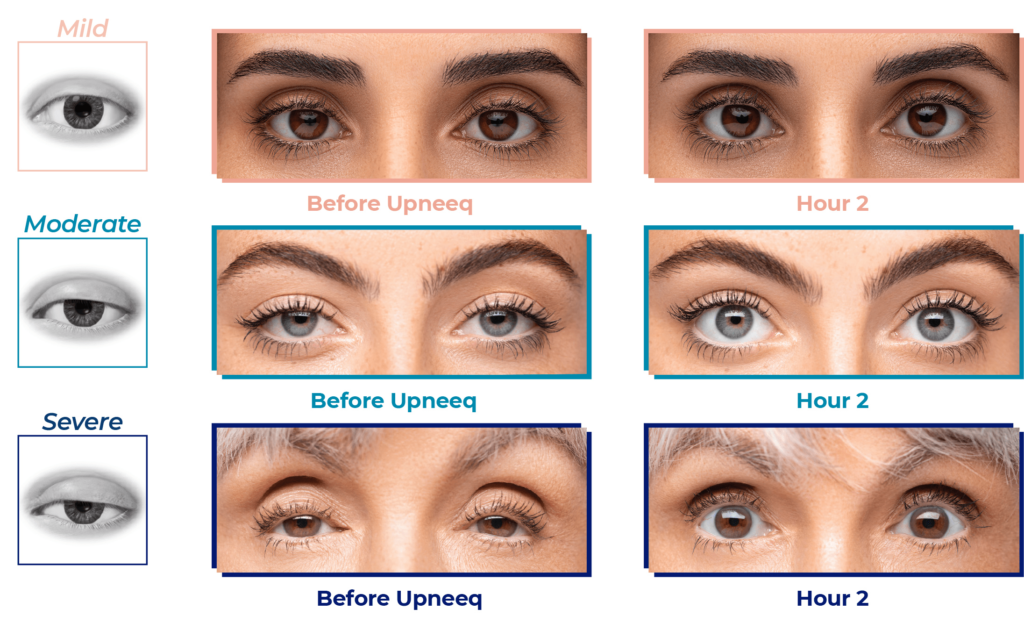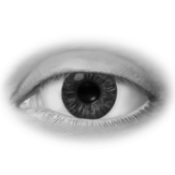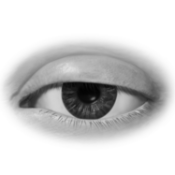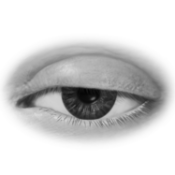UPNEEQ® EYE-OPENING LIFT

UpNeeq® Helps Lift the Eyelids, Improving Vision & Symmetry
Dr. Cynthia Diehl of Raleigh’s Diehl Plastic Surgery is excited to be able to provide UpNeeq®, the only FDA-approved prescription eye drop proven to lift the upper eyelids. If you have droopy eyelids, also known as acquired ptosis, you may be a candidate for treatment.
UpNeeq® is a once-daily eye drop that helps to correct acquired ptosis by lifting the upper eyelid, resulting in a significant improvement in the patient’s field of vision. While treatment can help improve asymmetry of the eyes, it can also help prevent eye strain, neck pain and headaches that occur from impaired vision.
UpNeeq® also improves your appearance since you look less tired and sleepy.
Frequently Asked Questions About UpNeeq®
Blepharoptosis also called acquired ptosis and typically referred to as droopy or low-lying eyelids. This can cause you to look tired and reduce your field of vision resulting in blurriness and headaches.
On label, UPNEEQ is a prescription eye drop used to treat acquired ptosis (or low-lying eyelids) in adults. However, it can also be used for those who want a more lifted, wide, and white eye aesthetic. UPNEEQ significantly improves the upper field of vision in those with ptosis by lifting the upper eyelids quickly, safely, and without any severe side effects. UPNEEQ’s effect begins between five and fifteen minutes after application, reaches maximum impact at 2 hours, and can last between eight to ten hours. It’s generally used once a day.
UpNeeq® contacts the Mueller’s muscle to lift eyelid. Treatment improves your eye symmetry; helping you look more awake and it can significantly improve your field of vision.
There is no downtime with this treatment. Side effects can include dry eye, redness, eye irritation, headache and punctate keratitis. It is important to review you medical history with our providers during your consultation.
There could be mild irritation, but generally 94% of patients experience no discomfort.
It is commonly said that the eyes are the windows to the soul and everyone wants to appear as alert and attentive as possible at home and in their professional lives. If you are an adult who wants a wider, lifted, white eye appearance or are bothered by drooping or sleepy appearance, and especially if you struggle with a reduced field of vision due to hooded eyelids, then you are an excellent candidate for UPNEEQ. Also, if you regularly wear contact lenses, lash extensions, or look at a computer screen for long hours, you may subconsciously be squinting your eyelid muscles and can also possibly benefit from UPNEEQ as a strain prevention. The only caution is with patients who have narrow-angle glaucoma or those with allergies to any of the ingredients. We advise discussing any eye conditions with your healthcare provider to determine if UPNEEQ is safe for you.
If you wear contacts, apply the drops first and wait 15 minutes before you put your lenses in. If you use other eyedrops, wait 15 minutes between drops.
Apply one drop per day in each affected eye.
What is UPNEEQ?
UPNEEQ® (oxymetazoline hydrochloride ophthalmic solution), 0.1% is a prescription eyedrop used to treat acquired blepharoptosis (low-lying lids) in adults.
What warnings and precautions are associated with UPNEEQ?
- Low-lying lids may be related to conditions such as stroke and/or brain aneurysm, Horner syndrome, myasthenia gravis, loss of the ability to move eye muscles, eye infection and eye tumors. Tell your doctor if you have any of these conditions.
- UPNEEQ is a type of medication that may affect your blood pressure. If you have heart disease, uncontrolled high or low blood pressure, or feel faint at rest or when quickly standing up, you should call your doctor if your symptoms get worse.
- Patients with reduced blood flow to the brain or heart, or patients who experience eye or mouth dryness due to an immune system disorder (Sjögren’s syndrome), should use care when taking UPNEEQ. Call your doctor immediately if you feel your symptoms may be getting worse.
- UPNEEQ may increase the risk of eye pressure due to fluid buildup (angle-closure glaucoma) in patients with untreated narrow-angle glaucoma. Call your doctor immediately if you feel increased pressure in your eye after using UPNEEQ.
- Do not let the tip of the UPNEEQ vial touch your eye or any other surface. This can help prevent eye injury or contamination. Each UPNEEQ vial is for one-time use and should be discarded after being used.
What are the most common side effects of UPNEEQ?
The most common adverse reactions with UPNEEQ (occurring in 1-5% of patients) were eye inflammation, eye redness, dry eye, blurred vision, eye pain at time of use, eye irritation, and headache.
What should my doctor know about before prescribing me UPNEEQ?
- Your doctor should review your full medical history before prescribing UPNEEQ.
- UPNEEQ belongs to a class of medication (alpha-adrenergic agonists) that may affect your blood pressure. Use UPNEEQ carefully if you currently take an alpha-adrenergic agonist medication to treat heart disease or an enlarged prostate. Patients taking beta-blockers, or other medications to treat hypertension or an abnormal heartbeat, should also be careful when using UPNEEQ.
- Patients who use a certain class of antidepressant medication (monoamine oxidase inhibitors) should also be careful when using UPNEEQ, as it may affect the way your body absorbs the medication.
These are not all of the possible side effects of UPNEEQ. Tell your doctor if you have any side effect that bothers you or does not go away. Call your doctor for medical advice about side effects.
To report side effects or product complaints, contact RVL Pharmaceuticals at 1-877-482-3788. You may also report side effects to the FDA by calling 1-800-FDA-1088 or visit www.fda.gov/medwatch.
This is a summary of the most important safety information for UPNEEQ. For more in-depth safety information, please review the full Prescribing Information for UPNEEQ.

Can you recognize acquired ptosis (low-lying lids)?




Acquired ptosis can lead to vision impairment
- Low-lying eyelid(s) can affect eyesight by not only blocking your vision, but also by reducing field of vision, which may interfere with day-to-day functions such as:
- Reading
- Driving
- Computer use
- Looking up without the need to tilt your head back

